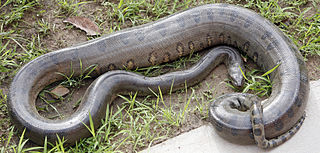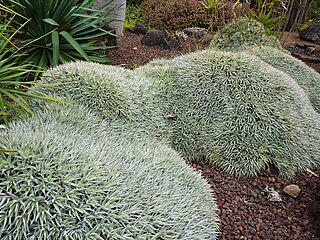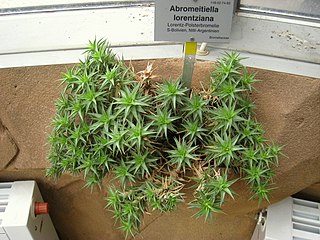
Anacondas or water boas are a group of large snakes of the genus Eunectes. They are found in tropical South America. Four species are currently recognized.

Bolivia, officially the Plurinational State of Bolivia, is a landlocked country located in western-central South America. The constitutional capital is Sucre, while the seat of government and executive capital is La Paz. The largest city and principal industrial center is Santa Cruz de la Sierra, located on the Llanos Orientales, a mostly flat region in the east of the country.

The Gran Chaco or Dry Chaco is a sparsely populated, hot and semiarid lowland natural region of the Río de la Plata basin, divided among eastern Bolivia, western Paraguay, northern Argentina, and a portion of the Brazilian states of Mato Grosso and Mato Grosso do Sul, where it is connected with the Pantanal region. This land is sometimes called the Chaco Plain.

Corumbá[koɾũˈba] is a municipality in the Brazilian state of Mato Grosso do Sul, 425 km northwest of Campo Grande, the state's capital. It has a population of approximately 112,000 inhabitants, and its economy is based mainly on agriculture, animal husbandry, mineral extraction, and tourism, being the gateway to the biggest wetlands of the world, the Pantanal. Due to its border with Bolivia, Bolivians in Brazil constitute a significant portion of the city's population, forming a distinct cultural community.

Madidi is a national park in the upper Amazon river basin in Bolivia. Established in 1995, it has an area of 18,958 square kilometres, and, along with the nearby protected areas Manuripi-Heath, Apolobamba, and the Manu Biosphere Reserve, Madidi is part of one of the largest protected areas in the world.

The dwarf brocket, or chunyi, is a small species of deer native to the Andean highlands in western Bolivia and southeastern Peru, where it is found in forest and páramo. Its pelage is reddish-brown with dark grey foreparts and neck. The underparts are lighter brown, and the muzzle short and thick. It weighs around 11 kg.
Chapare mammarenavirus is a virus from the family Arenaviridae and causes hemorrhagic fever. An outbreak of Chapare mammarenavirus infection occurred in the village of Samuzabeti, Chapare Province, Bolivia, in January 2003. A small number of people were infected. One person died. In 2019, two patients transmitted the virus to three healthcare workers in Bolivia’s de facto capital, La Paz. One of the patients and two medical workers later died.The specific transmission vector is not known, but is suspected to be a rodent, in keeping with other members of the arenavirus family, which includes Lassa mammarenavirus.

The Bolivian river dolphin, a mammal, is a species related to the Amazon river dolphin.

Deuterocohnia brevifolia is a species of plant in the family Bromeliaceae. This species is native to Argentina and Bolivia, but is also popular as a potted houseplant or ground cover elsewhere. A terrestrial species, it prefers sun or light shade and can grow in large dense mats of leaves given proper conditions.
Deuterocohnia bracteosa is a plant species in the genus Deuterocohnia. This species is endemic to Bolivia.

Deuterocohnia brevispicata is a plant species in the genus Deuterocohnia. This species is endemic to Bolivia.

Deuterocohnia glandulosa is a plant species in the genus Deuterocohnia. This species is endemic to Bolivia.

Deuterocohnia lotteae is a plant species in the genus Deuterocohnia. This species is endemic to Bolivia at altitudes of 2500–3000 meters.
Deuterocohnia chrysantha is a plant species in the genus Deuterocohnia. This species is endemic to Chile.

Deuterocohnia lorentziana is a plant species in the genus Deuterocohnia. This species is native to Bolivia.

Deuterocohnia meziana is a plant species in the genus Deuterocohnia. This species is native to Bolivia.
Deuterocohnia strobilifera is a plant species in the genus Deuterocohnia. This species is native to Bolivia.

Deuterocohnia schreiteri is a plant species in the genus Deuterocohnia.

Yates's big-eared bat is a species of leaf-nosed bat found in Bolivia.
Orites fiebrigii is a species of flowering plant in the protea family that is endemic to Bolivia.















